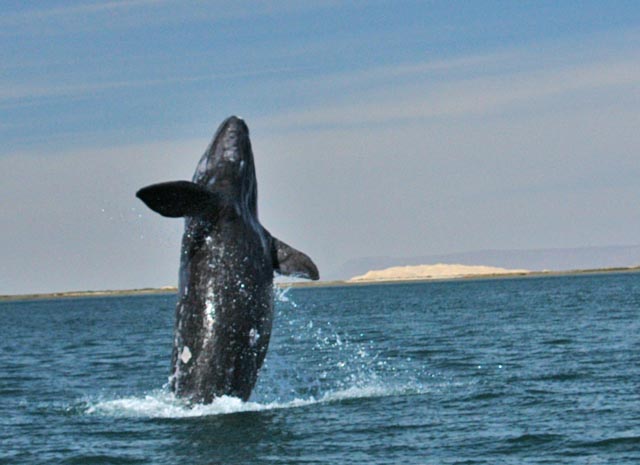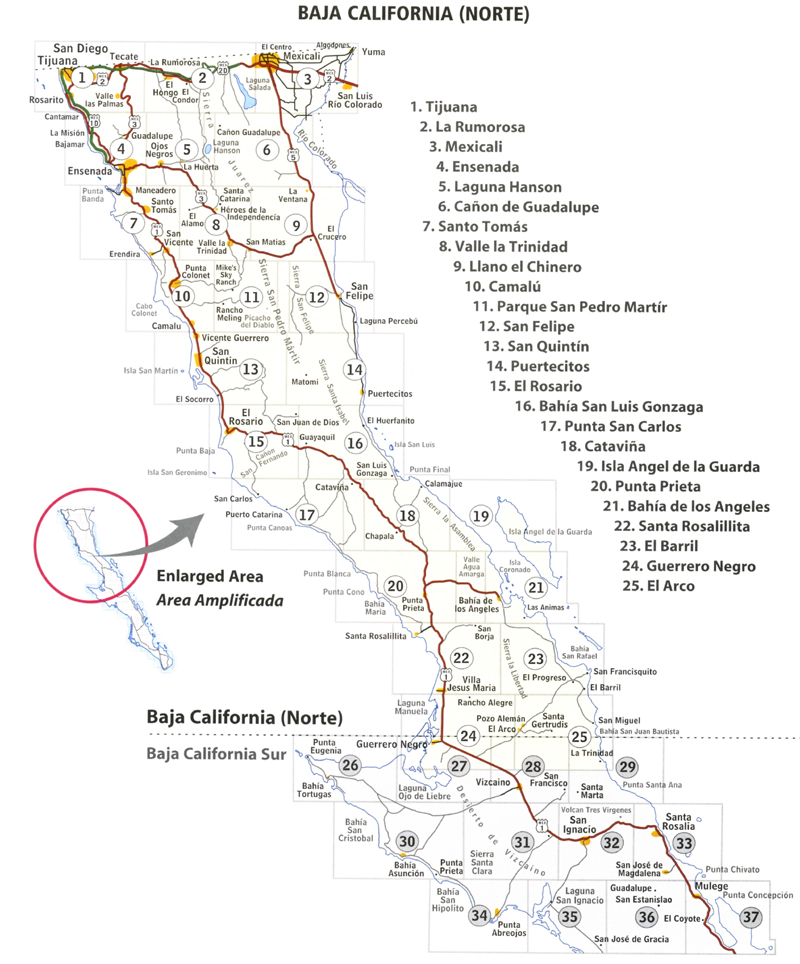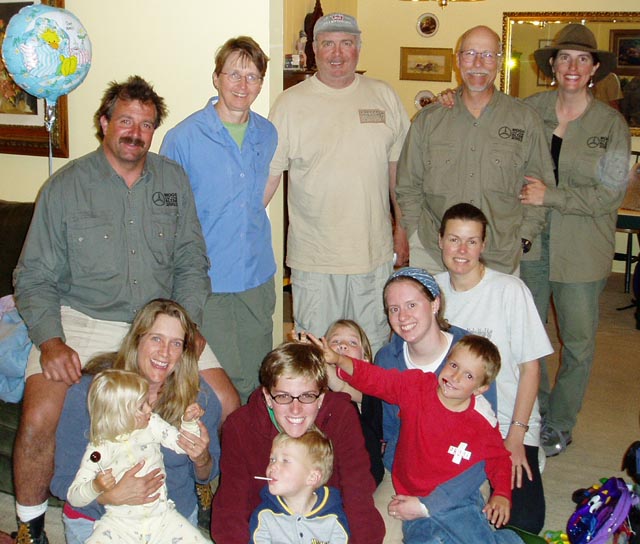Mexico Memories
Whales at San Ignacio Lagoon and San Quintin
March 2004
Back to Bill Caid's Home Page.

Baby Whale at San Ignacio Lagoon
A Whale of a Tale!
One of the many wonders of Baja California is the California Gray Whale. From January to March of every year they return to several of the big bays on baja's Pacific coast to give birth to their young and mate for the following year. This year, we decided that we would make the long trip to see the whales in their native environment. This was an extensive trip that spanned 8 days and had, in addition to long and hair-raising drives, some additional medical excitement. The pages below tell the story.
Every year the whales make the 12,000 mile journey from the northern Pacific to the San Ignacio and Ojo de Liebre lagoons for their spawning ritual. With the rise of eco-tourism, this has become big business. Most of the whale watchers go to the area around Guerrero Negro (Black Warrior) and stay in hotels in the area. We, on the other hand, elected to go to the more remote area around San Ignacio. There, we would see much less people and hopefully more whales.
The Maps
The following figures were from Baja California Almanac and show the index pages from the book. At $25, this book is reasonably priced, an outstanding value and is a great help when navigating the peninsula. I strongly recommend that you get it before you heading south as it is the best one that I have found. It is available, among other places, at the Map Center in San Diego as well as direct through their web site. They also sell a folding map that is not as detailed, but still provides great information. As you can see in the figures, the book a detailed section (2 pages) for each numbered region on the map. These are full topographic maps and include a section for traveler's notes.
As you can see, Baja is a big place. Nearly 1100 miles long, careful attention to logistics are required before you go. As any person who has been there can attest, services are not always as they seem. Just because there is a Pemex station does not mean they have fuel. Forewarned is forearmed, so go prepared with fuel and water. Be sure to arm yourself with the most recent information before you go. Oh, one other thing. Baja is a desert. Water is in short supply -- most of the time. Rains can take a casual situation and turn it into a crisis, washing out roads, bridges and other infrastructure. Recently, in the fall of 2003, a hurricane put ashore at La Paz causing substantial damage and interruption to traffic on the main north-south highway. You can be stranded for days should such an event occur, so insure that you have extra food and water to meet your needs. Even mild rains can cause interesting developments as the stories below will tell.

Figure 1. Baja California Norte (North)
The Team
The away team for this trip consisted of 4 vehicles, all (reasonably) seasoned travelers:
-
Bill Caid and Kathleen Jones from San Diego, CA in their Mercedes 1300L Unimog
-
Kai, Tina, Parker and Jackie Serrano from San Diego, CA in their Mercedes 416 Unimog
-
Mike, Carrie, Katie and Mitchell Bennett from Fresno in their converted Toyota Land Cruiser
-
Dan and Janet Johnson from Crawfordsville, IN in their Mercedes 1500L Unimog
-
Megan Johnson and friend Mackenzie Smith from Crawfordsville, IN in Dan's Dodge diesel pickup

Back, Left to Right: Kai, Janet, Dan, Bill, Kathleen
Front, Left to Right: Tina and Jackie, Mackenzie and Mitchell, Katie, Megan and Parker, Carrie
The Pre-Trip
Since this was a big trip and involved a major commitment of time for a significant number of working adults, it was decided that a pre-trip was a good idea. In the 2 weeks prior to the actual trip, Dan Johnson and Kai Serrano did a "speed run" to the proposed camping area to scope things out. This was a great idea, although it did involve some time and personal sacrifice on the part of the advance team. During the recon-trip, Dan was involved in a near-head-on accident with an eighteen wheeler while traveling at night. This was due to the narrow roads and a ms-estimation of position on the part of both drivers. While it did destroy the mirror and window on Dan's truck, and the window on the big-rig, no injuries were sustained. Nor did it involve the local police. Aside from the damage to the truck, the recon mission was successful in that it did identify good camping spots, places to eat and presence of 24 hour diesel and gas.
The Trip
Our trip to Baja involved 8 days and around a thousand miles of travel. During this trip we would see much of the main road in Baja, a number of cities along the route and, of course, the Pacific Gray Whales. Additionally, and unintentionally, we would see the hospital at Santa Rosalia and many miles of nighttime highway. The table below has links that will take you to the stories and photos of each of the days adventures. Each of the references below refer to the numbered points in the map above for convenience.
| Day | Date | Adventure |
|---|---|---|
1 |
2/28/2004 |
Tijuana to Guerrero Negro: Point 1 to Point 24 |
2 |
2/29/2004 |
Guerrero Negro to San Ignacio Lagoon: Point 24 to Point 35 |
3 |
3/1/2004 |
Whale watching at San Ignacio Lagoon: Point 35 |
4 |
3/2/2004 |
El Brazo Quebrada (broken arm) in San Ignacio: Point 32 to Point 33 and back |
5 |
3/3/2004 |
San Ignacio to San Quintin: Point 32 to Point 13 |
6 |
3/5/2004 |
Camping at San Quintin: Point 13 |
7 |
3/6/2004 |
Camping at San Quintin: Point 13 |
8 |
3/7/2004 |
San Quintin to the United States: Point 13 to Point 1 |
Traveler's Advice
Having made many trips into Mexico, every one is different and this one was no exception. Preparation and planning are critical for both having a good time as well as returning with your vehicle and person intact. Many obstacles exist on the roads in Mexico. I cannot count the number of flats that I have had, but I can say that there have been multiple occasions when I have had 2 flats at the same time. So, you need to be prepared to change flats yourself. Even if you were in an area where there was cell phone service, and that is rare, the auto club will offer no help. And, as we learned, your cell phone may not work in Mexico. Be self sufficient. And be cautious. Roads and bridges are narrow. Cattle and other livestock are on the road. Locals may drive vehicles without brake lights, or in some cases headlights, at night.
You will need liability insurance when you cross the border. It is not expensive, but the cost of not having it if you are in an accident will be very expensive. They will toss you in jail and the final outcome will be dependent on how much money you are willing to throw at the problem. Independent of insurance, accidents are best avoided, so drive within the limits of your skill and the conditions on the road. Seems like simple advice, but having been there many times, sometimes simple advice is not simple.
One final note given the medical emergency that we encountered on this trip. You need both a Plan B and an evacuation contingency. On this trip, we really did not have either. Happily, the injuries were not severe enough to be life threatening. But, they could have been. We had extreme difficulty in establishing contact with the US and never did succeed in getting the phone system to work. Our cell phones, while electronically functional, we unsuccessful in connecting with the Mexican network, so were useless. Should you expect that there will be issues, you should add Mexico to your calling plan or rent a satellite phone. Otherwise, you may be unpleasantly surprised should you need to communicate.
Copyright Bill Caid 2004